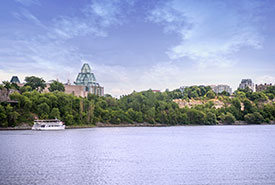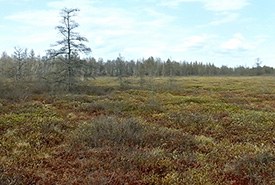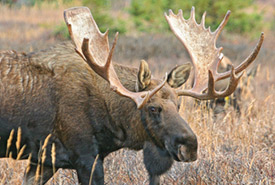Ottawa Valley Natural Area

Ottawa River (Photo by Ottawa Tourism)
Why this place is important
A land between two rivers
The Ottawa Valley Natural Area in Ontario includes over 16,300 square kilometres of land and waters between the Ottawa River and St. Lawrence River. The Natural Area corresponds with the Ontario portion of the St. Lawrence Lowlands Ecoregion. The Ottawa Valley Natural Area is rich in biodiversity, but is threatened by human development and activities, as well as invasive species. Our staff’s work in this area complements our efforts throughout the Outaouais on the Quebec side of the Ottawa River.
A rich diversity of habitats
The natural area includes a variety of habitats, including alvars, coastal wetlands, and bogs. These habitats are home to a variety of species, such as moose, spotted turtles and orchids. These habitats provide essential ecosystem services, such as flood protection for surrounding communities, water filtration, recreational opportunities and more.
Connections for wildlife
The Ottawa Valley Natural Area includes the eastern side of the Adirondack to Algonquin wildlife corridor and important north-south linkages in the Eastern Wildway Corridor that runs from the Gulf of Mexico to Quebec. Land securement and stewardship in the natural area will maintain and enhance important connections between the St. Lawrence River, the boreal forest of northern Ontario and Quebec’s Laurentian Mountains. Protecting natural corridors allows animals to freely move to new areas if they are faced with threats such as overpopulation, fire or food scarcity.
What NCC is doing here
The Nature Conservancy of Canada is working to have a more active presence in this natural area by:
- forging connections with neighbours and partners;
- engaging with Indigenous communities;
- securing land for conservation over the long term;
- stewarding and restoring habitats;
- enhancing visitor experiences on NCC properties; and
- supporting local conservation initiatives.
Some of this work can be found at the following NCC properties and areas of interest:
Gillies Grove – open to the public
Located along the Ottawa River, Gillies Grove contains some of the last remaining old growth forest in eastern Ontario. The grove is also home to Ontario’s tallest tree — a 47-metre-tall white pine. The property has an extensive trail system that allows visitors to enjoy the beauty of this ecosystem in a sustainable way.

Alfred Bog, ON (Photo by Wikimedia)
Alfred Bog – not open to the public
Located an hour east of Ottawa, Alfred Bog is the largest high-quality peat bog in southern Ontario, where it has built up over 10,000 years in an old oxbow of the Ottawa River. Alfred Bog is home to many plants and animals, including moose, waterfowl and carnivorous pitcher plants. It is classified by the Ontario Ministry of Natural Resources and Forestry as a Provincially Significant Wetland and an Area of Natural and Scientific Interest.
What lives there
Many significant and at-risk species can be found in the Ottawa Valley Natural Area, such as:
Birds
- bobolink – threatened in Canada and Ontario
- loggerhead shrike – endangered in Canada and Ontario
Plants
- eastern prairie fringed-orchid – endangered in Canada and Ontario
- ram’s-head lady’s-slipper – alvar species, rare in Ontario

Moose (Photo from Pixabay)
Mammals
- Algonquin wolf – endemic to Canada. Special concern nationally, threatened in Ontario
- moose
Reptiles, fish and molluscs
- spotted turtle – endangered in Ontario
- hickorynut mussel – endangered in Canada and Ontario
- American eel – endangered in Ontario
- lake sturgeon – endangered in Ontario (Great Lakes population)
Threats
Like so many other natural areas across the province, invasive species continue to be a primary threat here. Eradicating these species, which crowd out native plants and alter habitat, is one of NCC’s goals for the area. Each year, NCC staff, partners and volunteers work hard in the forests, wetlands and lakes of the natural area, removing species such as common buckthorn, dog-strangling vine and phragmites. NCC also promotes awareness through workshops and the media to encourage the public to help reduce the spread of invasive species.
The natural area also faces growing threats from urban expansion and resource extraction. These practices lead to habitat loss and fragmentation, which affect the survival of many species.
Statistics Canada forecasts the human population of eastern Ontario will increase by almost 30 per cent between 2018 and 2046. With a greater number of people in the area and more development occurring across the landscape, the conservation of wildlife habitat is increasingly important. While about one-half of the natural area features natural cover, such as forest or wetland, only about three per cent of the landscape has been secured for conservation, to date.
Partners
NCC cannot protect the Ottawa Valley alone. Only through strong partnerships can this unique area continue to thrive. NCC thanks the following partners for their conservation work and generous support of our ongoing efforts in this natural area:
- Cataraqui Conservation
- Eastern Ontario Model Forest
- Mississippi Madawaska Land Trust
- Mississippi Valley Conservation Authority
- Mississippi Valley Field Naturalists
- Ontario Parks
- Ottawa Field-Naturalist’s Club
- Pembroke Area Field Naturalists
- Raisin Region Conservation Authority
- Rideau Valley Conservation Authority
- Rideau Waterway Land Trust
- South Nation Conservation
- St. Lawrence River Institute
- Vankleek Hill and District Nature Society
A priority for conservation
Please consider a gift to help protect and care for the Ottawa Valley Natural Area.






